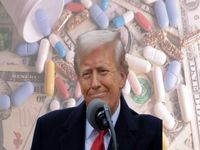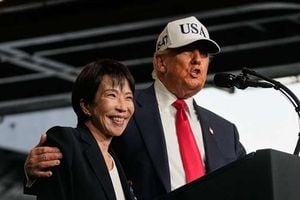On September 25, 2025, President Donald Trump ignited a firestorm in both the business and political worlds by announcing sweeping new tariffs on a range of everyday goods, including pharmaceutical drugs, kitchen cabinets, upholstered furniture, and heavy trucks. The tariffs, set to take effect October 1, are among the most aggressive import taxes imposed in recent U.S. history, and their impact is already rippling through American industries and households alike.
Trump’s plan, detailed in a series of posts on his social media platform, calls for a 100% tariff on pharmaceutical drugs, 50% on kitchen cabinets and bathroom vanities, 30% on upholstered furniture, and 25% on heavy trucks. The president justified the move by citing national security and other pressing concerns, declaring that foreign manufacturers were “flooding the United States with their products” to the detriment of domestic industry. As The Associated Press reported, Trump stated, “Large Truck Company Manufacturers, such as Peterbilt, Kenworth, Freightliner, Mack Trucks, and others, will be protected from the onslaught of outside interruptions.”
These tariffs, according to the administration, stem from Section 232 investigations launched earlier this year into the national security implications of importing pharmaceutical drugs and trucks. The Commerce Department also began probing timber and lumber imports in March, potentially laying the groundwork for the furniture-related tariffs. While some experts have questioned the logic of labeling kitchen cabinets and sofas as national security priorities, the administration has pressed ahead, framing the tariffs as crucial to revitalizing American manufacturing and reducing the federal deficit.
But the reaction among economists, industry leaders, and everyday Americans has been swift and anxious. The new levies arrive at a time when U.S. consumers are already grappling with high living expenses, a shaky job market, and persistent inflation. According to The Economic Times, Dr. Wayne Winegarden of the Pacific Research Institute warned that the 50% tariff on kitchen cabinets and bathroom vanities could force homeowners to delay or abandon remodeling projects. “You’re dealing with housing affordability, broad affordability issues,” Winegarden said. “If you’re going to put a tax on sinks, kitchen cabinets, bathroom vanities, you’re gonna get people purchasing less of them.”
Furniture retailers, too, are bracing for impact. Upholstered furniture imports accounted for 42% of all such products sold in the U.S. as recently as 2020, with China, Vietnam, and Mexico as the main suppliers. Michael Goldman of CARU Containers remarked, “It’s really no secret that China is a huge player in kitchen cabinets. Bathroom vanities? China is a huge player.” For companies like Naturepedic, a mattress and furniture firm near Cleveland, the tariffs have thrown business plans into chaos. “Do we continue forth … and hope for the best?” asked Arin Schultz, the company’s chief growth officer, in an interview with The Associated Press. “Or do we feel like we’re priced out and drop it altogether?”
For pharmaceutical drugs, the stakes are even higher. The U.S. imported nearly $233 billion in pharmaceutical and medicinal products in 2024, according to Census Bureau data. Traditionally, these imports have been exempt from tariffs, but Trump’s new 100% tax marks a dramatic shift. Alex Schriver of the Pharmaceutical Research and Manufacturers of America cautioned, “Every dollar spent on tariffs is a dollar that cannot be invested in American manufacturing or the development of future treatments and cures.” The prospect of prices doubling for some medicines has alarmed patients, health care providers, and insurers alike, with some experts warning of potential shortages and increased rationing of essential drugs.
Trump, for his part, has insisted that the pharmaceutical tariffs will not apply to companies that are “breaking ground” or “under construction” with new manufacturing plants in the U.S. Several major drugmakers—including Johnson & Johnson, AstraZeneca, Roche, Bristol Myers Squibb, Eli Lilly, and Merck—have already announced investments in U.S. production, moves the White House attributes in part to the threat of tariffs. Nevertheless, the administration has not clarified how the exemptions will apply to companies with existing factories or those producing generic drugs, which make up most U.S. prescriptions.
The tariffs’ economic impact is already being felt. Federal Reserve Chair Jerome Powell recently warned that increases in goods prices are contributing to the current inflationary environment. “We have begun to see goods prices showing through into higher inflation,” Powell said at a news conference, noting that these costs account for “most” or potentially “all” of the increase in inflation this year. Despite this, Trump has publicly claimed that inflation is “no longer a challenge,” even as the consumer price index has risen 2.9% over the past 12 months, up from 2.3% in April. Since April, manufacturers have cut 42,000 jobs and builders have downsized by 8,000, according to the Bureau of Labor Statistics.
Retailers and homebuilders are equally concerned. The National Association of Realtors reported that while sales listings increased by 11.7% in August, the median price for an existing home was $422,600—already a stretch for many buyers. Jonathan Gold, vice president of supply chain and customs policy at the National Retail Federation, warned, “Adding significant costs to furniture, cabinets, vanities and building materials will make the American dream of owning a home significantly more expensive. The speed at which these tariff announcements are made and implemented continues to wreak havoc on retail supply chains.”
Some industry experts believe that larger companies with stronger margins may be able to absorb some of the new costs, at least temporarily. However, smaller businesses—especially those dependent on a single product line—may have no choice but to pass the increases along to consumers. Others, like Ken Mahoney, CEO of Mahoney Asset Management, suggest that the tariffs may not “materialize and will be adjusted or completely revoked” depending on the outcome of trade negotiations, particularly with China. “If [U.S. officials] want something more out of China or feel like China is coming to the table in a really good way, I could completely see these tariffs being delayed, suspended, something like that,” Goldman added.
The legal underpinnings of Trump’s tariff policy are also under scrutiny. While the Section 232 investigations provide a national security rationale for some of the new levies, Trump has previously relied on emergency powers under the International Emergency Economic Powers Act (IEEPA)—a move that two federal courts have ruled exceeded his presidential authority. The Supreme Court is set to hear arguments on the case in November, but as Harvard’s Robert Lawrence explained to The Associated Press, the Section 232 approach gives Trump “insurance” should his broader tariff strategy be struck down.
For now, the only certainty is uncertainty. As businesses, consumers, and policymakers scramble to assess the fallout, the nation is left to wonder whether these tariffs will achieve their stated aims—or simply make life more expensive for millions of Americans. With the clock ticking toward October 1, all eyes are on Washington, and the stakes for the U.S. economy couldn’t be higher.






